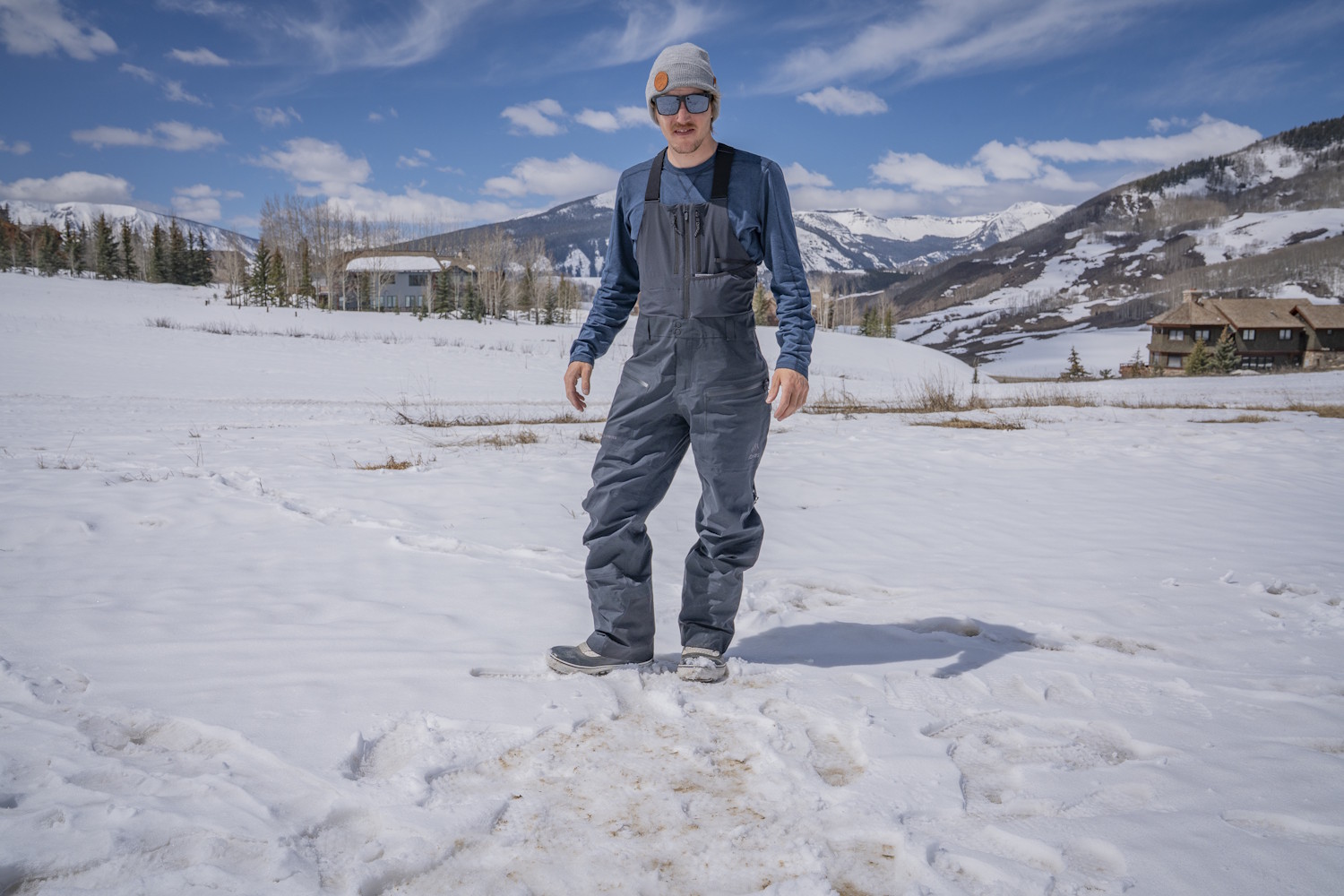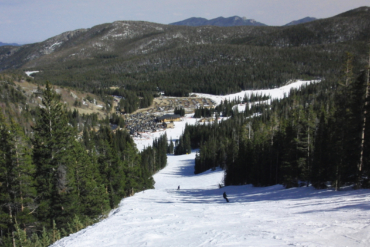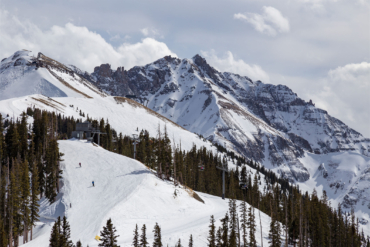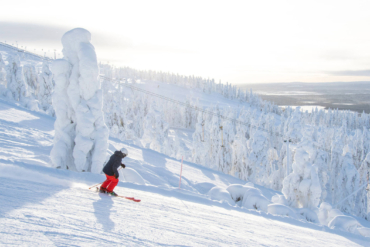With the first layers of snow touching the ground and resorts beginning to open, ski season is all but here. Are your legs ready to rock an 8-hour resort day or a few thousand feet of touring? Here’s how to whip yourself into ski shape.
After a midseason MCL sprain last winter, I committed to being 100% physically ready for ski season this year. But, as a fairly new skier, I really had no idea where to begin — except doing a whole lot of squats.
So I called up a professional athlete-turned-ski coach Sam Naney to find out what it really takes to physically prepare for the rigors of ski season. Naney grew up cross-country skiing in the magical Methow Valley in northeastern Washington and went on to a professional career before retiring from the sport in his late 20s.
He runs his own ski coaching business and contributes to Uphill Athlete, a training blog that relies on structured and individualized regimens for skiers, climbers, and mountaineers alike.

Why Train in the First Place?
The biggest reason to train is to be able to have fun! No one enjoys heading home halfway through that one ski day out of the week just because their legs couldn’t last.
Being able to show up at the parking before first chair and know that your legs will keep you going until last chair is a great feeling. So is venturing out for a ski tour and knowing you won’t be last on the skin track.
But there’s another reason to train as well: to avoid injuries. Tired legs, bogged down by all the snow on that first pow day, will struggle to protect delicate tendons. And should you catch an edge, you’ll risk tumbling and tearing an ACL.
“Injuries quite often occur because a muscle or a joint or a ligament goes beyond the range that is trained in, and then it either gets pulled or torn or broken,” Naney said.
Of course, not all injuries can be prevented. But with proper preparation and training, there is a lot you can do to be an adaptable, strong, and prepared skier.
When to Train for Skiing
“Start where you are at,” Naney recommended. “Wherever you are at, it is worth it.” If you find 30 minutes a day to go for a jog or do an ab workout, or strength train, it will be better than nothing.
And now is the time to start. As Naney said, it takes time to make these metabolic and structural changes to the aerobic system, changes that will help us perform all day once we get into the midst of ski season. If you try to cram it all into the week or two before you hit the slopes, you’re not going to be ready.
How to Train for Skiing
There are three important factors for skiing training: strength, aerobic fitness (cardio), and flexibility. Being fit in all three of these disciplines will allow you to ski all day with less risk of injury or exhaustion.
Strength
When it comes to building strength for skiing, there are a few things to keep in mind. The first is to build progressively. If you start at the end, with lots of weight and lots of time, you risk injury. So it’s best to begin by building up the time you train and work up to a goal — say, 90 minutes. Then, add weight to continue adding difficulty to your workouts.
For skiing, you will want to focus on specific muscle groups that are especially important.
Abdominals
When working on your core for skiing, it’s crucial to focus on the deep abdominal musculature. This holds you upright and supports dynamic movement, Naney pointed out. Those six-pack muscles won’t help you when it comes to maintaining core tension through ski turns. It’s better to focus on the transverse abdominis and the obliques, the less flashy muscles.
Core exercises for skiing:
- Front planks
- Hanging knee raises, aka “kayakers” (follow this tutorial)
- Bicycles
These activities require a long engagement of those important abdominal muscles that help keep you upright while skiing. When doing these exercises, start with your longest time. Work up to 60-90 seconds of each, and then add weight.
Naney recommends all of his athletes get a weighted vest, as gym training will be less accessible due to COVID-19.
Legs
Of course, when it comes to skiing, the biggest muscles you use are in your legs. But it turns out that just doing squats isn’t the best way to prepare those quads for skiing.
“The squat is both feet planted, and you’re in one perfect plane. Very rarely when you are skiing are you in that perfect position,” Naney said.
While he does recommend doing squats to train those big muscles, he also said to make sure you don’t leave out the stabilizing muscles. That’s what will allow you to adjust when you hit some crud or a chunk of ice in the trail and find yourself on one ski.
Leg stability exercises for skiing:
- Single-leg deadlifts
- Forward T
- Star/compass touch (stand on one leg, reach down and touch all four points on the compass around your foot)
Training with these balancing exercises also helps your neuromuscular connectivity. “The brain becomes more adept at telling the muscles what to do. And that is really what strength is. Most people have the sheer muscle mass to do the sport they want to do. The thing that is missing is having that mass be smart enough to do it,” Naney said.
I have personally adopted the leg blaster as my main leg ski season training, with the addition of these stabilizing exercises Naney has highlighted. Leg blasters train eccentric muscle movement. Currently, I’m working up to being able to do five leg blasters with a 15- to 30-second rest between sets.
Leg blasters:
- 20 squats
- 10 alternating forward lunges on each leg (20 total)
- 20 jump lunges
- 10 jump squats
Cardio
“Aerobic fitness is essentially your body’s ability to utilize fat as a fuel,” said Naney. Exercising always burns some combination of fat and carbohydrates. Shifting that percentage toward fat creates less fatigue and is more efficient than burning carbohydrates.
Especially when it comes to backcountry touring, but even on lift-served skiing, it’s important to have a certain level of cardio fitness. For a resort day, not being aerobically fit might mean you’re unable to take lap after lap or having to pause in the middle of a run to catch your breath. But, in the backcountry, not having enough cardio fitness could mean getting caught in a bad situation and being too tired to make confident and safe decisions.
A variety of low-intensity exercises is the best way to train the aerobic system for skiing, said Naney. For touring, this could be hiking uphill for a long time. After a while, adding a moderately weighted pack helps to simulate what the tour might feel more like. Long, slow runs could also be a good way to train that cardio fitness needed for all types of skiing.
Flexibility
“A flexible muscle is a strong muscle, and a strong muscle is a flexible muscle,” Naney noted. As long as you’re moving through a variety of ranges in your strength training, you should develop plenty of flexibility as well.
A simple flexibility routine is to spend 5-10 minutes moving each joint through its full range. Start at the feet and ankles, work up to the hips and shoulders, and, finally, your neck.
For a more ski-tuned option, check out Naney’s own 10-minute mobility workout.

Sample Ski Training Week
Monday
- Mobility workout
- Leg blasters
- Leg stability
Tuesday
- Cardio: 30-60 minutes of hiking uphill or jogging
- Core: 30 seconds of each exercise in this Uphill Athlete Core video
Wednesday
- Mobility workout
- Leg blasters
- Leg stability
Thursday
- Cardio: 30-60 minutes of jogging, biking, or hiking
- Core: Same as Monday
Friday
- Mobility workout
- Leg blasters
- Leg stability
Saturday
- Option 1: Adventure day! Get out and do something outside, whether that’s a long run, a hike, rock climbing, biking, etc.
- Option 2: Take a rest day
Sunday
- Cardio: 30 minutes light jogging
- Core: Same as Monday
Just Do It
“You get good at what you do,” said Naney. “If you want to have the ability to be balanced and strong on one ski, then train the ability to balanced and strong on one foot.”
He said to be specific with your training and keep your components separate, at least at the beginning of your training. Train your strength separate from your cardio to get that solid foundation before putting it all together.
The most important part of training is the frequency. Carve those 20-30 minutes out of your busy day to get a workout in. Once you have a routine that works for you, then add duration. Hopefully, you find yourself in a positive feedback loop where you look forward to your next workout.
Of course, if you can get more in, you will get fitter, said Naney. But something is always better than nothing.








